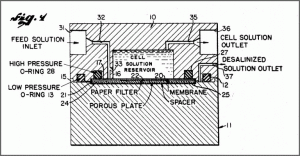
Clean Water for All
By UCLA Samueli Newsroom
UCLA engineers developed the first reverse osmosis membrane, an important technology to clean water worldwide. That research legacy continues at the school.
Clean, useable water from dirty water? More than 50 years ago, that’s exactly what two UCLA engineers did for water technology by developing the world’s first practical reverse osmosis membrane.

Today, that legacy continues at the UCLA Samueli School of Engineering, with several faculty members leading research groups exploring cutting-edge clean water technologies. The longest-tenured among them is Yoram Cohen, a distinguished professor of chemical and biomolecular engineering who is internationally renowned for his water desalination and membrane technology research.
The concept of reverse osmosis is simple – brackish liquid water is pushed by pressure through a membrane that keeps the dissolved salts at bay and results in water that is now clean enough to drink.
It is called reverse osmosis (RO) because it is the opposite of a natural phenomenon, known as osmosis. Imagine two water streams with differing levels of salinity, and they are separated by a semi-permeable membrane. Water from the higher salinity stream will naturally move across the membrane into the fresher water stream – the process of osmosis – until the water on both sides reaches thermodynamic equilibrium.
But what if you could reverse that process? The result would produce clean, potable water from brackish water, from such sources such as from agriculture runoff, industrial wastewater, or even sea water.
Two UCLA engineering graduate students, Sidney Loeb and Srinivasa Sourirajan, made that process possible, with research starting in the late 1950s. The pair created the first practical RO membrane using cellulose acetate. They filed for a patent on the new membrane in 1960.
Following further refinement by Loeb, their groundbreaking RO membrane was first successfully demonstrated on a large-scale in 1965 at a water treatment plant in Coalinga in California’s Central Valley. The RO plant was operated by UCLA and remained online for seven years.
Today, reverse osmosis membrane technologies are used around the world, with about 65% of the world’s desalination operations using RO membranes where the availability of freshwater is scarce.
Cohen’s laboratory is located on the same floor in Boelter Hall where the historic RO membrane was developed.
Today, Cohen and his students are developing a new generation of RO membranes using innovative nano-structured surface designs, as well as intelligent water desalination systems that optimize energy use.

“RO membranes are a mature technology but advances in materials science over the past decade have opened up new avenues,” said Cohen, who is also a member of UCLA’s Institute of the Environment and Sustainability and the director of the Water Technology Research Center, or WaTeR. “The major challenge in membrane based desalination is to reduce the cost of water production, in particular in reducing membrane fouling, the buildup of mineral scale, and to further reduce the total energy consumption.”
One of Cohen’s advanced practical technologies is the Smart Integrated Membrane System, or SIMS. This mobile system fits into a standard cargo container and can purify contaminated groundwater into water clean enough to drink. SIMS, which can be operated remotely, can purify up to 35,000 gallons of agricultural drainage water per day, or enough for about 100 households. This same technology can be used to reduce the salinity of such water, so it can be reused for irrigation.
“From my perspective, clean water is not only a technology problem, it is also a significant societal problem,” he said. “In fact, in the future, it could be the most critical problem facing the state, as it already is for many places around the globe. I don’t just want to produce excellent research, but I want our advancements in science and technology to contribute to solving societal needs. This is why the WaTeR Center research team has been so actively involved here in California in developing intelligent distributed water desalination and purification systems and in solving water issues for disadvantaged communities.”
Cohen and his students are now at work in the Salinas Valley, the productive agricultural region that stretches from Monterey Bay in the north to King City in the south. They are working to deliver an RO-based technology to purify contaminated and saline local groundwater sources for disadvantaged communities, providing them with safe, potable water.
“In fact, with climate change, where we get our clean fresh water may dramatically shift,” Cohen said. “This is why desalination technologies could play a much larger role for the state’s water use than it has before.”
Cohen notes that going forward, it’s also important to look at water in the greater context of energy use and food production. This emerging concept is known as the water-energy-food nexus.
“How much energy does it take to produce and convey water to it use location?” he asked. “And how much water is required for energy and food production? These are major questions that require a great deal of intense research. And they are questions that researchers across UCLA and many others around the world, are working on.”
